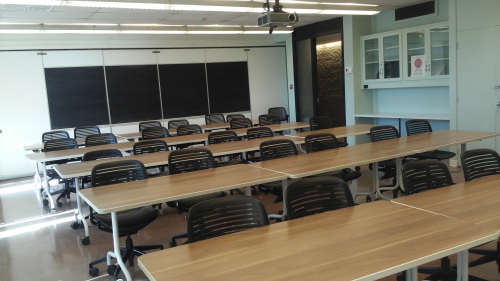- Location: 3700 rue McTavish, Montreal, QC
- Capacity: 30 students
- Type: Flat classroom
Alignment with principles for designing Teaching and Learning Spaces
Academic challenge
Promote individual, active engagement with content.
Layout
Students can work individually or in groups at rectangular tables.
Acoustics: Acoustic design mitigates distraction from outside and inside sources.
Furniture
Mobile furniture (including tables and comfortable, adjustable, ergonomically approved chairs with wheels) permits rapid room reconfiguration for different learning activities.
Technologies
Access to resources: Learning Management System, internet (via student laptops). Multiple sources (projector, SMARTBoard) for display of different learning materials.
Lighting & colour
Windows and overhead lighting support individual work during or outside of class time.
Learning with peers
Promote active engagement with one another.
Layout
A flexible layout with rectangular tables permits students to collaborate with one another and configure the space in multiple ways, moving easily from small group (2-4 students) to whole class activities. Students are able to move about easily in the classroom due to sufficient passing space between tables. Sight lines are unobstructed.
Acoustics: Sound zones support multiple simultaneous conversations among students.
Furniture
Comfortable, adjustable-height chairs on wheels permit students to turn to discuss and work with those next to or behind them. The chairs and the flip-top tables on wheels allow for multiple configurations of the classroom to support a variety of collaborative learning approaches.
Technologies
Shared workspaces include multiple blackboards and a SMART Board.
Lighting & colour
Natural and overhead lighting gives ample light for group work.

Experiences with faculty
Promote interaction and communication.
Layout
Instructor is not limited to the “front of the room” and instead has access to all students due to easily mobile furniture and a small mobile instructor podium, allowing them to move around the room with greater ease.
Acoustics: Sounds zones ensure that not only are students able to hear the instructor, but that the instructor is also able to hear the students.
Furniture
The small, mobile podium provides space for instructional materials and is height adjustable. Mobile furniture for students supports different teaching strategies. Cabinets and closets provide ample storage space for materials.
Technologies
A data projector and SMART Board permit display of different learning materials.
Lighting & colour
Natural and overhead lighting support teaching tasks.
Contributions to the campus environment
Classrooms that incorporate elements of active and collaborative learning are part of a vision for a variety of flexible campus learning spaces. This room is designed for all populations using the space: well-lit, with a standardized room control panel that simplifies instructors’ use of equipment in classrooms across campus. IT is consistent with teaching and learning needs, and durable furniture contributes to sustainability efforts. Both physical and virtual affordances help maximize High Impact Practices (HIPs) for student learning within and beyond this classroom.
